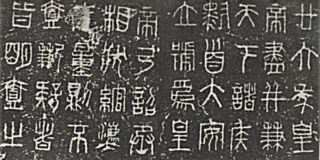
Xiaozhuan
Encyclopedia

Li Si
Li Si was the influential Prime Minister of the feudal state and later of the dynasty of Qin, between 246 BC and 208 BC. A famous Legalist, he was also a notable calligrapher. Li Si served under two rulers: Qin Shi Huang, king of Qin and later First Emperor of China—and his son, Qin Er Shi...
, prime minister under the First Emperor of China
China
Chinese civilization may refer to:* China for more general discussion of the country.* Chinese culture* Greater China, the transnational community of ethnic Chinese.* History of China* Sinosphere, the area historically affected by Chinese culture...
, Qin Shi Huangdi, and promulgated for use during the first imperial dynasty of China, the Qin Dynasty
Qin Dynasty
The Qin Dynasty was the first imperial dynasty of China, lasting from 221 to 207 BC. The Qin state derived its name from its heartland of Qin, in modern-day Shaanxi. The strength of the Qin state was greatly increased by the legalist reforms of Shang Yang in the 4th century BC, during the Warring...
Before the Qin
Qin Dynasty
The Qin Dynasty was the first imperial dynasty of China, lasting from 221 to 207 BC. The Qin state derived its name from its heartland of Qin, in modern-day Shaanxi. The strength of the Qin state was greatly increased by the legalist reforms of Shang Yang in the 4th century BC, during the Warring...
conquest of the last remaining six of the Seven Warring States
Seven Warring States
The Seven Warring States or Seven Kingdoms refers to the seven warring states in China during the Warring States period of Chinese history...
of China, local styles of characters
Chinese character
Chinese characters are logograms used in the writing of Chinese and Japanese , less frequently Korean , formerly Vietnamese , or other languages...
evolved independently of one another for centuries producing what are called the scripts of the Six States (六國文字). Under one unified government however, the diversity was not deemed desirable for two main reasons: first, it hindered timely communication, trade, taxation, and transportation, and second, independent scripts might represent dissenting political ideas, especially in areas where the suppressed Confucian tradition remained strong.
Hence coaches, roads, currency, laws, weights, measures and writing were to be unified systematically. Characters which were different from those found in Qin were discarded, and xiaozhuan characters as defined by Li Si became the standard for all regions within the empire. The unification came in about 220 BC
220 BC
Year 220 BC was a year of the pre-Julian Roman calendar. At the time it was known as the Year of the Consulship of Laevinus/Catulus and Scaevola/Philo...
, and was introduced by Li Si and two ministers. The small cursive form clerical script
Clerical script
The clerical script , also formerly chancery script, is an archaic style of Chinese calligraphy which evolved in the Warring States period to the Qin dynasty, was dominant in the Han dynasty, and remained in use through the Wèi-Jìn periods...
came after the small script.
Li Si's compilation is known only through Chinese commentaries through the centuries. It is purported to contain 3,300 characters. Several hundred characters from fragmentary commentaries have been collected during the Qing period, and recent archeological excavations in Anhui, China, have uncovered several hundred more on bamboo strips to show the order of the characters; unfortunately, the script employed is not the small seal script as the discovery dates from Han times.

